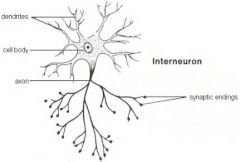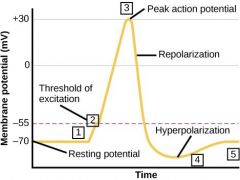![]()
![]()
![]()
Use LEFT and RIGHT arrow keys to navigate between flashcards;
Use UP and DOWN arrow keys to flip the card;
H to show hint;
A reads text to speech;
27 Cards in this Set
- Front
- Back
|
Sensory neurones |
Detect changes in surroundings
Transducers - convert energy from one form to another Each type adapted to detect a certain type of energy Change is called a stimulus Light - photoreceptors Smell and taste for chemicals - chemoreceptors Touch - mechanoreceptors Heat - thermoreceptors |
|
|
Pacinian corpuscle |
Pressure sensor on skin
Rings of connective tissue Pressure causes change in shape of connective tissue so push against nerve endings to physically open gated sodium channels Stop responding when pressure is constant |
|
|
Functions of neurones |
Transmit stimulus energy along neurones as an action potential
Sensory neurones - sensory receptor to central nervous system Motor neurones - carry an action potential from the CNS to an effector such as a muscle or gland Relay neurones - connect sensory and motor neurones in CNS |
|
|
Structure of neurones |
Long so travel over large distance
Have many gated ions channels and sodium/potassium pumps Cell body contains nucleus and normal organelles Axon carries impulses away from the cell body Dendrons / dendrites carry impulses towards the cell body Myelin sheath |
|
|
Sensory neurone |
Long dendron as cell body just outside CNS
Short axon carrying action potential into CNS Start with sensory receptors and end in synaptic endings in CNS |
|
|
Sensory neurone structure |

|
|
|
Relay neurone |
Connect sensory and motor neurones in the CNS
Many short dendrites where action potentials enter the cell Short axon to synaptic endings to motor neurones Conduct coordinated pathways |
|
|
Relay neurone structure |

|
|
|
Motor neurone |
Have cell body in CNS
Long axon that carries the action potential to the effector |
|
|
Motor neurone structure |

|
|
|
Myelination |
Schwann cells on axons and dendrons which make a fatty membrane around Nodes of Ranvier at intervals without myelin but very short It prevents the movement of ions across the membrane so movement of ions only at nodes of Ranvier Same local current across and only ions movement at nodes of Ranvier so action potential jumps across from one node to another Called saltatory conduction |
|
|
Non-myelinated neurones |
One loosely wrapped Schwann cell
Action potential moves along in a wave rather than jumping between nodes |
|
|
Advantages of myelination |
Transmit to action potential much faster - rapid response to stimulus
Means the nerve can be longer |
|
|
Resting potential |
Sodium/potassium pumps - 3 Na+ ions moved in for 2 K+ ions
Membrane is polarised Lots of ATP so lots of mitochondria as active transport Membrane is polarised -60mV is potential gradient across membrane Gated sodium channels are closed |
|
|
Generating an action potential |
Stimulus causes the opening of Na+ ion channels to create a generator potential
So Na+ ions diffuse into the cell If the stimulus is large enough then more Na+ ion channels will open so more Na+ diffuse into the cell and the threshold potential is reached as the potential difference increase If only some Na+ ion channels open and it doesn’t reach the threshold potential the nerve does nothing - all or nothing Once the threshold potential has been reached the Na+ voltage gates open so there is a large influx of Na+ ions into the cell Called depolarisation and the potential difference reaches +40mV Example of positive feedback Creates an action potential which are always the same magnitude +40mV |
|
|
Repolarisation |
Sodium voltage gates close and potassium voltage gates open
Potassium diffuses out of the cell so potential difference becomes more negative called repolarisation The potential difference overshoots slightly so more negative than resting potential called hyperpolarisation Resting potential is restored by the sodium/potassium pumps called refractory period and means action potentials only in one direction |
|
|
Membrane potential graph |

|
|
|
Frequency of impulses |
All the action potentials have the same magnitude of +40mV so don’t show size of stimulus
The larger the stimulus, the more action potentials are created in the same amount of time |
|
|
Local currents |
Local current created when sodium voltage gates open in the cytoplasm
The sideways diffusion along the neurone of Na+ ions creates the local current Opens more sodium voltage gates as it moves along to cause depolarisation all along Once the action potential has passed a point the sodium/potassium pumps redistribute the Na+ ions |
|
|
Saltatory conduction |
Na+ and K+ ions cannot diffuse through myelin sheath
Gaps between myelin called nodes of Ranvier are the only places to have ionic movement to elongate the local currents The action potential jumps from one node to the next Speeds up transmission |
|
|
Synapses |
A junction between 2 or more neurones so they can communicate
Small gap called synaptic cleft An action potential can’t move across the gap so causes the release of a chemical to generate the action potential in the next neuron Synapses use acetylcholine as the neurotransmitter are cholinergic synapses |
|
|
Pre-synaptic bulb |
Pre-synaptic neurone ends in bulb
Has many mitochondria for ATP Large amount of smooth endoplasmic reticulum that packages the vesicles Lots of acetylcholine in vesicles Voltage-gated calcium ion channels |
|
|
Post-synaptic membrane |
Contains sodium ion channels that respond to the neurotransmitter
Receptors specific for the acetylcholine |
|
|
Transmission across the synapse |
An action potential arrives at the synaptic bulb
Voltage-gated calcium ion channels open so Ca2+ ions diffuse into the cell The Ca2+ ions cause vesicles containing the neurotransmitter to move the the plasma membrane and be released into the synaptic cleft by exocytosis Acetylcholine diffuses across the cleft and binds with receptors on the post-synaptic neuron Sodium ion channels open so there is a large influx of Na+ ions to create an action potential if it is above the threshold potential |
|
|
Acetylcholinesterase |
Acetylcholine is left in the synaptic cleft so needs to be broken down so it doesn’t cause another action potential
Acetylcholinesterase stops the transmission and products re-enter to be recycled |
|
|
Summation |
Can connect more than 2 neurones
More than one neuron can go into a single neuron at a synapse One neuron can go into many neurons at a synapse so spread all over body One neuron has an excitatory post-synaptic potential (EPSP) and may not be enough to reach an action potential in the next neuron It may take several EPSPs to create an action potential so need combined effect called summation Can be from several action potentials from one neuron or from different neurones combined |
|
|
Advantages of synapses |
Allow pathways as split and converge
Can become habituated when run out of neurotransmitter Filter out low-level stimulus Can be amplified by summation Mean only in one direction |

